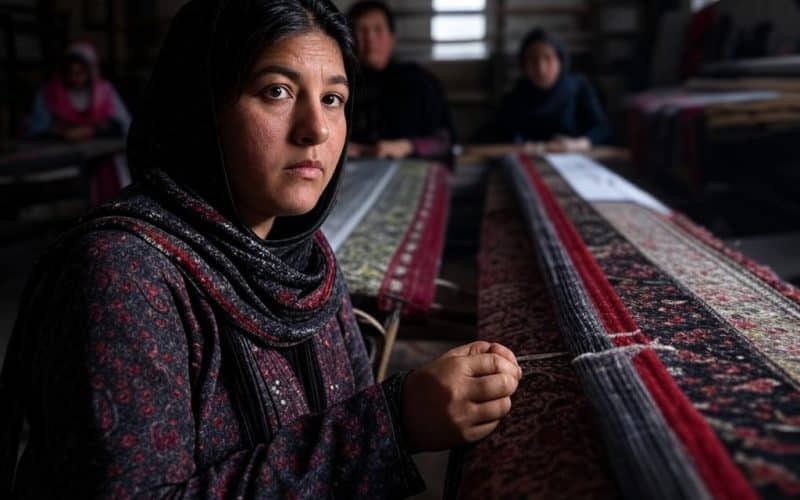
As of March 2025, approximately 2.2 million girls in Afghanistan are barred from attending school beyond the sixth grade due to the Taliban’s restrictions on female education. It’s nothing less than a school ban. This figure includes an additional 400,000 Afghan girls who have been deprived of education since the previous year.
If the current ban persists, projections indicate that by 2030, over four million girls will suffer from the school ban.
Women have also been pushed out of professional life, barred from sectors such as education, media, public administration, and healthcare. With few legal job options left, many have turned to carpet weaving – a trade steeped in history but now rebranded as survival.
As a result, thousands of Afghan girls and women spend long days bent over looms, tying knots into intricate carpets, in dim, overcrowded workshops across the country. Their work is precise, exhausting, and almost entirely invisible to those who buy the finished product abroad.
Afghan Girls after School Ban – From Classrooms to Workshops
The shift from education due to the school ban to low-paid labor has been abrupt and brutal. Teenagers who once aspired to become doctors, lawyers, or teachers now spend 10 to 12 hours a day on factory floors, earning less than a dollar per day. The average weaver is paid around $27 for every square meter of carpet, work that often takes a month to complete.
Afghan girls turn to low-paid carpet weaving after school ban https://t.co/CVuBJgsONA
— BBC News (World) (@BBCWorld) April 15, 2025
Girls who once sat in classrooms now share rooms with their families and looms. Some are still traumatized from violent attacks on schools in recent years. Many were withdrawn by relatives fearing for their safety. Others were forced out simply because the schools shut down and never reopened.
Growing Exports, Shrinking Lives
Despite the country’s economic collapse, the carpet industry is thriving. In the first half of 2024 alone, Afghanistan exported more than 2.4 million kilograms of carpets, generating $8.7 million. These exports are destined for countries including Pakistan, India, Austria, China, Turkey, France, and the United States.
Yet the women behind the looms see none of those profits. In local markets, carpets fetch between $100 and $150 per square meter. Weavers are paid a fraction of that. Some say pieces they worked on sold abroad for thousands of dollars, while they received nothing extra – not even a mention.
The labor is intensive, often performed in windowless rooms without ventilation. Many start young, learning from older relatives or neighbors after formal education is cut off.
False Promises and Vanishing Futures
The Taliban government has repeatedly claimed that schools for girls will reopen once Islamic curriculum standards are met. But no timeframe has been announced, and no concrete steps have been taken. In the meantime more than 2.2 million girls remain out of school – a number that continues to rise.
For many families, weaving has become the only means of survival. Entire households now rely on one or more daughters working at looms, their youthful ambitions replaced by the repetitive motion of tying knots.
Some still hold on to education in secret, studying languages or basic science in underground lessons. A handful pursue online courses quietly, using phones or borrowed internet access. But these are rare exceptions.
Afghanistan’s carpets are admired around the world for their craftsmanship and cultural value. But each knot also tells a quieter story – of futures diverted, of childhoods cut short, of a generation left behind.
For the women behind the looms, the work is not a passion or a calling. It’s the only option left.
Gender Apartheid
Afghan girls are enduring a multifaceted crisis under Taliban rule, facing severe restrictions that affect nearly every aspect of their lives. These compounded restrictions have led to what many international observers describe as “gender apartheid,” systematically erasing women and girls from public life and denying them basic human rights.
Apart from educational deprivation there are more restrictions they face.
1. Health Care Access
The Taliban has prohibited women from pursuing medical education, including training as midwives and nurses. This policy exacerbates the already dire maternal health situation, particularly in remote regions like Badakhshan province, which has the highest maternal mortality rate in Asia . The lack of female medical professionals further limits women’s access to essential health services.
2. Economic Marginalization
Women have been largely excluded from the workforce, with bans on employment in most sectors. This exclusion has led to increased poverty among women and their families, forcing some into informal or low-paid labor, such as carpet weaving, to survive.
3. Mental Health Crisis
The systemic removal of women from public life has led to a significant mental health crisis. A U.N. report indicates that 68% of women rate their mental health as ‘bad’ or ‘very bad,’ citing depression, anxiety, and hopelessness as common issues . The lack of access to mental health services further exacerbates this crisis.
4. Increased Gender-Based Violence
There has been a rise in gender-based violence, including forced marriages, domestic abuse, and honor killings. The absence of legal protections and support services leaves many women vulnerable and without recourse.
5. Restrictions on Movement and Expression
Women are required to be accompanied by a male relative when traveling beyond certain distances and are mandated to wear full-body coverings in public. They are also banned from speaking or singing in public, effectively silencing their voices in society.
6. Social Isolation
The closure of public spaces to women, including parks, gyms, and beauty salons, has led to increased social isolation. This isolation not only affects mental health but also limits opportunities for community building and support networks.
International Engagement Remains Inconsistent
The future for Afghan girls under Taliban rule is grim. Deprived of secondary and higher education since 2021, more than 2.2 million girls remain locked out of classrooms. If this ban continues, the number could exceed four million by 2030. Afghanistan now stands alone as the only country in the world to prohibit girls from attending school beyond the sixth grade – a decision with irreversible social and economic consequences.
These restrictions extend far beyond education. Girls face an environment of enforced dependency and fear, where opportunities for growth are deliberately erased. With women banned from most jobs, many girls grow up knowing that their career options are confined to household labor or low-paid trades like carpet weaving. For some, childhood ends with the closing of a classroom door. Their future becomes one of forced domesticity, economic marginalization, and social isolation.
The ban on medical education for women has also triggered a silent health crisis. With fewer female doctors and midwives, access to maternal and reproductive healthcare has deteriorated – especially in rural areas like Badakhshan, where maternal mortality rates are among the highest in Asia. Meanwhile, mental health is collapsing under the weight of systemic despair. A large majority of Afghan women now describe their mental health as “bad” or “very bad”, with anxiety, depression, and trauma becoming widespread and untreated.
Despite this, international engagement remains inconsistent. For lasting change, the global community must take a coordinated, multi-layered approach. Diplomatic pressure is crucial. Targeted sanctions and travel bans against Taliban leaders can increase accountability. Meanwhile, international donors should redirect funding toward grassroots women’s organizations that operate under the radar, offering education, psychological support, and vocational training.
Alternative schooling must be urgently scaled. This includes online education, home-based tutoring, and underground learning centers—models that already exist but require protection and funding. For girls and women at high risk, resettlement programs and international scholarships can provide life-changing pathways.
Additionally, the international legal community must push for the recognition of gender apartheid as a crime against humanity. This legal framing would strengthen advocacy and enforcement mechanisms, offering a route to justice for those targeted under the current regime.
Restoring basic rights to Afghan girls is not just a humanitarian obligation; it’s a moral and strategic necessity. Education empowers. It stabilizes communities, drives economic recovery, and fosters long-term peace. Ignoring the systematic erasure of girls from public life risks condemning an entire generation to poverty, invisibility, and trauma.
To reverse this trajectory, the international community must act not in statements, but in strategy – supporting Afghan girls not only with words, but with schools, networks, protection, and sustained visibility.
